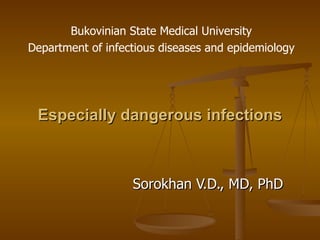
Lecture 8. anthrex, plague
- 1. Especially dangerous infections Sorokhan V.D., MD, PhD Bukovinian State Medical University Department of infectious diseases and epidemiology
- 11. Pathology B . anthracis remains in the capillaries of invaded organs, and the local and fatal effects of the infection are due, in large part, to the toxins elaborated by B . anthracis. Histopathology of mediastinal lymph node showing mediastinal necrosis. Image courtesy of Marshall Fox, MD, Public Health Image Library, US Centers for Disease Control and Prevention, Atlanta, Georgia.
- 12. Pathology Histopathology of mediastinal lymph node showing a microcolony of Bacillus anthracis on Giemsa stain. Image courtesy of Marshall Fox, MD, Public Health Image Library, US Centers for Disease Control and Prevention, Atlanta, Georgia. Anthrax in the spore stage can exist indefinitely in the environment. Optimal growth conditions result in a vegetative phase and bacterial multiplication. Secondary hemorrhagic intestinal foci of anthrax result from B . anthracis bacteremia.
- 13. Pathology Primary intestinal anthrax predominantly affects the cecum and produces a local lesion similar to the lesion produced in the cutaneous form. Oropharyngeal anthrax is a variant of intestinal anthrax and occurs in the oropharynx after ingesting meat products contaminated by anthrax. Histopathology of large intestine showing marked hemorrhage in the mucosa and submucosa. Image courtesy of Marshall Fox, MD, Public Health Image Library, US Centers for Disease Control and Prevention, Atlanta, Georgia.
- 14. Pathology Histopathology of the large intestine showing submucosal thrombosis and edema. Image courtesy of Marshall Fox, MD, Public Health Image Library, US Centers for Disease Control and Prevention, Atlanta, Georgia. Inhalation anthrax occurs after inhaling spores into the lungs. Spores are ingested by alveolar macrophages and are carried to the mediastinal lymph nodes. Anthrax in the lungs does not cause pneumonia , but it does cause hemorrhagic mediastinitis and pulmonary edema. Hemorrhagic pleural effusions frequently accompany inhalation anthrax.
- 21. Clinic Cutaneous anthrax. Image courtesy of Anthrax Vaccine Immunization Program Agency, Office of the Army Surgeon General, United States. The membrane or exudate of the ulcer contains numerous anthrax bacilli.
- 34. Plague
- 62. Thank you for your attention!